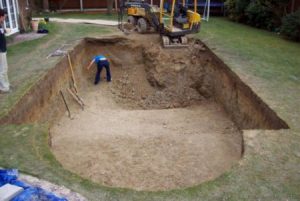Building your swimming pool
Here are the necessary steps you should adhere to before building your pool:
1. What is its function?
Will it be indoors or outdoors, back or front, will it be primarily used by children or adults? Choosing a bowl is probably the best way to go, so that it will be universal and suitable for all the family, including the young and the more chronologically gifted.
Indoor pools require lots more space than outdoor, and are usually more expensive to build, but on the plus side – use is not restricted to season or weather, or time of day – and night of course.
Outdoor pools are more commonplace and are easier to site and construct. With regard to features, or even art, the possibilities are endless.
Natural pond lookalikes are becoming increasingly popular. They are still fitted with all the proper equipment like pumps and filters.
First off, decide what type of pool you want. If it’s an in-ground pool in the backyard, remember maintenance and construction costs are high – which makes this one the more expensive options.
Another option is to first purchase an inflatable pool, even if it’s just to gauge how often the swimming pool will be in use. A myriad of designs, sizes and shapes are available to choose from, and won’t break the bank, and best of all, there are no construction costs.
2. Choose the bowl size and shape
The cost of the pool is dependent on its size. Naturally, the bigger the pool, the higher the cost of construction. Rectangular pools are by far the most cost effective to build – material consumption is lower geometric dimension accuracy is higher. If you are looking for something more aesthetically pleasing, you may want to opt for a more rounded shape. The choices are vast.
3. Construction docs
You can look through model projects online or order sets of drawings with step by step instructions on construction. These drawings can simplify construction and assembly of your project.
A proper construction plan is vital to the success of the project, because not only will it aid the construction, it will help you to monitor construction and maintenance costs as you progress. Remember to take into consideration the hidden construction costs – things like retaining walls for example –
- Retaining walls required: A proper drainage system to adequately maintain the pool is essential, but you also need to guarantee the stability of the construction; enter retaining walls.
- More concrete may be needed: most people will plan the exact amount of construction materials that will be required, but unless you’ve working in that industry for many years, there’s always the danger you’ll miscalculate.
- Disposing of the dirt post digging – you could be very surprised by the amount of dirt produced – factor in the expense of removal.
- Damage caused by construction – heavy plant equipment could wreak havoc with your garden or lawn, you may need to replace or at best reseed your lawn.
- Electricity and extra lighting for additional power outlets, pumps etc….budget for those!
- Fencing – if you want add-ons, even down the line, build this into your project costings. You could save yourself a bundle of money, time and energy.
4. Select the equipment you need for your swimming pool
Decide what pool filtration system you will have, skimmer or overflow. The latter option is more expensive. With a skimmer, the water level falls to 5’’ below the border. The skimmer filter then collects water from the surface for cleaning, making it a great choice.
An overflow system has a compensation capacitance and the water level is flush with the border. For pools that need to be built outside it is desirable to use embedded parts made of stainless steel.
Other versions can be built with embedded plastic parts, for example in a concrete tub in a private house. Other considerations: hydro therapy, air massage, fountains and waterfalls. Experts can help your make the right choices.
Extra equipment you may need to budget for include gas pool heaters, solar pool blankets, and control panels.
Gas heaters may be required – if gas your thing – to heat the pool when the sun is just not strong enough. Many different gas heaters are available, and prices vary according to specs.
A pool blanket will be required to keep the pool clean when not in use. Some pool blankets come as a combo with a solar heater – can work out a little pricey, but a great bonus for people in warmer climates. Special pool cover reels can be used to streamline installation and storage.
Make sure you have good pool filters and pumps – they help to prevent algae and keep the water clean. Control panels and boards keep the pumps, heaters, etc running smoothly – ensure they are well maintained.









